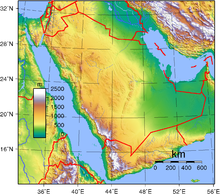Arabic plate

In plate tectonics, the Arabian plate is one of the smaller continental plates that encompasses the Arabian Peninsula and adjoining sea areas and extends northwards towards south-east Turkey . Although the Arabian Peninsula is geographically part of Eurasia , the Arabian Plate has a close geological relationship with Africa .
Geographical location
The tectonic plate borders the African plate in the west and southwest, the Indian plate in the southeast, the Eurasian plate in the east and the Anatolian plate in the north. In addition, together with the African Plate, it forms the rift of the Red Sea and the northern part of the Great African Rift Valley .
Plate edge

The southwest divergent plate boundary (diverging) lies in the Red Sea, which among other things creates the 244 m high volcano Jabal at-Tair , but it also extends to the eastern African continent. There, in the volcanically active Afar Depression , lies the triple point where three plate edges meet. Even a small piece of the divergent plate boundary eastwards from there leads ( Aden-back ) to the east the Gulf of Aden in transform faults (such as the Owen Fracture Zone ) and in the Murray-back in the northern Arabian Sea to pass that one Is marginal sea of the Indian Ocean .
The northeast of the Arabian plate is a largely convergent plate boundary (colliding). The plate boundary begins in the east near the Iranian-Pakistani Makran coast in the Arabian Sea. The subduction of oceanic crust created the volcanoes Bazman and Taftan, which are no longer active today, 500 km to 600 km north . The plate boundary goes inland in the Strait of Hormuz , crosses some western Iranian provinces, where continental crust bulges to the Zāgros Mountains , and ends in eastern Anatolia , Turkey. The Taurus Mountains and the Armenian Highlands were formed there by the mountain formation .
In the northwest lie Transformstöruneng ( East Anatolian Fault and Transform Fault of the Dead Sea ), which, starting from southeastern Turkey, forms the western plate boundary and leads over the course of the Orontes and the Jordan Rifts to the Gulf of Aqaba into the Red Sea.
shape
The Red Sea is an up to 2604 m deep, 2240 km long and relatively narrow tributary of the Indian Ocean, which every year widens by 0.8 cm in the north and 1.6 cm in the south.
The geologically oldest part of the Arabian Plate is the Arabian Shield , which is located next to the Red Sea. Here are the Hejaz , the Asir Mountains and, in Yemen, the 3760 meter high mountain Jabal an-Nabi Shuʿaib .
In the center and partly in the east of the Arabian Plate, the Precambrian rock that came to the surface in the west is covered by an increasing layer of sedimentary rock that is more than 10 kilometers thick . There are large underground salt basins, some of which have been transformed into salt domes . Due to impermeable rock layers, deposits of oil and natural gas have also arisen there. The largest oil fields are the Ghawar oil field in Saudi Arabia and the Burgan oil field in Kuwait. The largest gas field is the north field in Qatar, which is continued in Iran. There are other deposits on the Iranian and Iraqi sides of the Persian Gulf and in the Mosul area in Iraq. In the Omangebirge there are ophiolites , i.e. the former ocean floor pushed onto the mainland.
Geological history
100 million years ago the Arabic plate was still part of the African plate. The Arab-Nubian shield had formed 580 million years ago, but the land adjacent to it to the east was still under water. At that time, the Tethys Ocean was located between the African and Eurasian plates . This ocean began to close 90 million years ago due to intraoceanic subduction and for about 50 million years ( Eocene ) the former sea floor has been bulging . The Arab-Nubian shield began to part and form the Red Sea . About 20 million years ago ( Miocene ) the Tethys began to transform into an increasingly shallow strait. Around 15 million years ago, the first islands emerged, which kept increasing in number and size, in order to then ultimately form a land connection between Asia and the Arabian Peninsula. When the Mediterranean dried up about 5 million years ago during the Messinian Salinity Crisis , the land connection was clearly in place. From these once flat landscapes, large fold mountains have emerged today , for example the Zagros Mountains have existed since the Pliocene .
Web links
- Tectonics of the Arabian Plate. ( Memento from May 5, 2003 in the Internet Archive ) NASA
- CR Scotese: Palaeomap Project.
- GEOS 427/527, Orogenic Systems: ZAGROS MOUNTAIN RANGE, SW IRAN. University of Arizona
Individual evidence
- ↑ M. Mokhtari: Main structural elements of Makran (Sea of Oman) region based on seismic data and required Tsunami Early Warning System. (PDF file; 31 kB)
- ↑ M. Barazangi, D. Seber, M. Vallve, E. Fielding, B. Isacks: A Geological and geophysical Information System for Eurasia, the Middle East and North Africa: 3.2.8. Basement Map of the Middle East.
- ↑ ethz.ch: JP Burg: OMAN: an autopsy orogen. (PDF; 2.8 MB)
- ↑ M. Reuter, WE Piller, M. Harzhauser, O. Mandic, B. Berning, F. Roögl, A. Kroh, M.-P. Aubry, U. Wielandt-Schuster, A. Hamedani: The Oligo- / Miocene Qom Formation (Iran): evidence for an early Burdigalian restriction of the Tethyan Seaway and closure of its Iranian gateways. (PDF; 2.0 MB)


